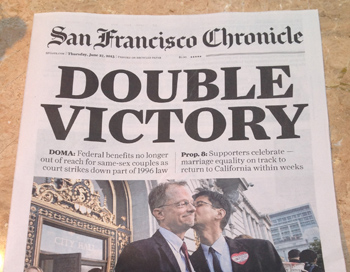| |
A Newsworthy Week
By PETER FUNT
PUBLISHED: June 27, 2013 |
|
|
If you woke up Thursday in San Francisco, you may have seen the boxcar headline "DOUBLE VICTORY" atop the San Francisco Chronicle's front page, the start of a 12-page report -- a print celebration, really -- on the U.S. Supreme Court's rulings regarding same-sex marriage.
But if you happened to be in Alabama, you saw something quite different on page one of The Tuscaloosa News, the somber one-column headline: "Battles ahead on same-sex marriage."
|
 The stark difference in how newspapers treated the landmark rulings underscores the country's regional and political divide. It also raises questions about how editors shape the news, at a time when the public's view of media often seems as fractured as the topics being covered. The stark difference in how newspapers treated the landmark rulings underscores the country's regional and political divide. It also raises questions about how editors shape the news, at a time when the public's view of media often seems as fractured as the topics being covered.
Whether a news outlet is headquartered in the progressive epicenter of Northern California or in the deepest corner of the Old South, editors must interpret the news for readers, beginning with the headline and front-page treatment. What is the proper path? Should the coverage be flatly objective, as with the Denver Post's, "Historic gains in gay rights forged with pair of rulings"?
Or, should the reports reflect the presumed leaning of local readers, such as the Bakersfield Californian's banner, "A GIANT STEP"? Or, in Kansas, the Wichita Eagle's, "Rulings on marriage create challenges"?
In Columbia, S.C., The State newspaper decided on the headline, "In S.C., joy, dismay greet rulings on same-sex marriage." In Oregon, The Statesman Journal cooed, "An enormous victory."
The Times of Shreveport, La., appeared to stretch facts concerning the marriage rulings to the limit with the page-one headline, “Both sides claim victories.”
Other editors just couldn't be bothered. The Middletown Press in Connecticut overshadowed the marriage story with news that a local deli would be closing. The small headline on the landmark decision said, "State, country react to DOMA ruling."
Of course, if you woke up in New York on Thursday you saw that the city’s two hyperbolic tabloids rarely let news judgment interfere with sensationalism. The News and Post both devoted page one to murder charges against the football player Aaron Hernandez. Said the Post, “DEADLY PLAY,” while the News went with, “HIT MAN.”
The stories on gay marriage were just part of a topsy-turvy period in which events pushed emotions to extremes, and set media, both conventional and social, ablaze. As the week began, coverage and opinion was sharply divided on the Supreme Court's decision to curb key provisions in the Voting Rights Act. Then, environmentalists and their opponents quickly shifted gears to deal with President Obama's sweeping plans to combat carbon pollution. Some papers, such as the Columbian in Washington State didn't even mention Obama's environmental speech on page one, an editorial judgment which, itself, spoke volumes.
By the time the rulings on marriage were handed down, editors and readers were in such a lather that it was hard to maintain focus on equally contentious topics, such as George Zimmerman's racially charged murder trial in Florida.
What we can gather from this busy week is that mainstream newspapers often allow their political leanings to influence treatment of controversial news. Moreover, papers often seek to reflect the sense of the region they cover, even if it differs from the majority view nationwide.
We are also reminded that although many newspapers have been weakened financially in recent years, when significant events happen, their front pages are still the main source for what The Washington Post long ago labeled, “the first rough draft of history.”
(c) Peter Funt. This column was originally distributed by the Cagle Syndicate.
|
|
|
Index of Previous Columns


|
|
|



 The stark difference in how newspapers treated the landmark rulings underscores the country's regional and political divide. It also raises questions about how editors shape the news, at a time when the public's view of media often seems as fractured as the topics being covered.
The stark difference in how newspapers treated the landmark rulings underscores the country's regional and political divide. It also raises questions about how editors shape the news, at a time when the public's view of media often seems as fractured as the topics being covered.